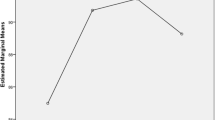Abstract
Background
Patient safety is recognised as an important aspect of the undergraduate medical curriculum. However, packed medical curricula have been slow to evolve despite repeated mandates and large-scale tragedies resulting from unlearnt lessons. The aim of this work was to explore students’ perspectives on patient safety to inform curriculum re-design.
Methods
Using a qualitative approach, medical students from year 2 and year 4 of the undergraduate course were invited to participate in focus groups to consider: their personal conceptualisation of patient safety, their perceptions of patient safety education in the existing curriculum and their collective preferences for future teaching in this area. Transcripts of the focus groups were subjected to thematic analysis.
Results
Six focus groups were convened with a total of 77 students. Thirteen major themes were identified which included conceptual ambiguity, healthcare culture, error theory, specific safety topics (such as infection prevention and control, medication safety, technical/procedural safety, communication and other non-technical skills), self-awareness, patient-centredness, low student morale and raising concerns. Students were more aware of technical than non-technical competence. They wanted learning aligned to the realities of practice, a clearer concept of patient safety and improved visibility of patient safety topics within an integrated curriculum.
Conclusions
Students are keen to engage with safety topics but frequently feel disempowered as future change agents. Educators need to advocate a clear definition of patient safety and consider the implication of the theory-practice gap on students’ evolving attitudes.

Similar content being viewed by others
References
Brennan T, Leape L, Laird N, Herbert L, Localio A, Lawthers A. Incidence of adverse events and negligence in hospitalized patients. N Engl J Med. 1991;234:370–6.
Vincent C, Neale G, Woloshynowych M. Adverse events in British hospitals: preliminary retrospective record review. BMJ. 2001;322:517–9.
Kohn L, Corrigan J, Donaldson M. To err is human: building a safer health system. Washington DC: National Academies Press; 2000.
Department of Health. An organisation with a memory: report of an expert group on learning from adverse events in the NHS. London: HMSO; 2000.
Health Foundation. The measurement and monitoring of safety. London: Health Foundation; 2013.
Francis R. Report of the mid Staffordshire NHS Foundation trust public inquiry. London: HMSO; 2013.
Manser T. Teamwork and patient safety in dynamic domains of healthcare: a review of the literature. Acta Anaesthesiol Scand. 2009;53:143–51.
Reeves S, Lewin S, Espin S, Zwarenstein M. Interprofessional teamwork for health and social care. Oxford: Wiley-Blackwell; 2010.
Dekker S. The field guide to understanding ‘human error’. Farnham: Ashgate; 2014.
Dekker SWA, Leveson NG. The systems approach to medicine: controversy and misconceptions. BMJ Qual Saf. 2014;24:7–9.
World Health Organization. Patient safety curriculum guide: multi-professional edition. Geneva: WHO Press; 2011.
Berwick D. A promise to learn—a commitment to act: improving the safety of patients in England. London: Department of Health; 2013.
Gurses AP, Ozok AA, Provonost PJ. Time to accelerate integration of human factors and ergonomics in patient safety. BMJ Qual Saf. 2012;21:347–51.
Bleakley A. Broadening conceptions of learning in medical education: the message from teamworking. Med Educ. 2006;40:150–7.
Anderson ES, Gray R, Price K. Patient safety and interprofessional education: a report of key issues from two interprofessional workshops. J Interprof Care. 2016;31:154–63.
Waterson P, Catchpole K. Human factors in healthcare: welcome progress, but still scratching the surface. BMJ Qual Saf. 2016;25:480–4.
Sandars J, Bax N, Mayer D, Wass V, Vickers R. Educating undergraduate medical students about patient safety: priority areas for curriculum development. Med Teach. 2007;29:60–1.
Kerfoot BP, Conlin PR, Travison TT, McMahon GT. Patient safety knowledge and its determinants in medical trainees. J Gen Intern Med. 2007;22:1150–4.
Ginsburg LR, Tregunno D, Norton PG. Self-reported patient safety competence among new graduates in medicine, nursing and pharmacy. BMJ Qual Saf. 2013;22:147–54.
Nie Y, Li L, Duan Y, Chen P, Barraclough BH, Zhang M, et al. Patient safety education for undergraduate medical students: a systematic review. BMC Med Educ. 2011;11:33.
General Medical Council. About the outcomes for graduates: working with doctors and working for patients. Consultation document. London: GMC; 2017.
Knowles M. The adult learner: a neglected species. Houston: Gulf Publishing; 1973.
Bandura A. Social foundations of thought and action: A social cognitive theory. Englewood Cliffs: Prentice Hall; 1986.
Schön DA. The reflective practitioner: how professionals think in action. New York: Basic Books; 1983.
Kolb DA. Experiential learning: experience as the source of learning and development. Englewood Cliffs: Prentice Hall; 1984.
Denzin NK, Lincoln YS. Introduction: the discipline and practice of qualitative research. In: The sage handbook of qualitative research. 3rd ed. Thousand Oaks: Sage Publications; 2005. p. 1–32.
Kuper A, Reeves S, Levinson W. An introduction to reading and appraising qualitative research. BMJ. 2008;337:404–7.
Braun V, Clarke V. Using thematic analysis in psychology. Qual Res Psychol. 2006;3:77–101.
Rees CE. The problem with outcomes-based curricula in medical education: insights from educational theory. Med Educ. 2004;38:593–8.
Newton J. Group conformity: the legacy continues. Med Educ. 2014;48:842–3.
Walton MM. Teaching patient safety to clinicians and medical students. Clin Teach. 2007;4:1–8.
Ladden MD, Bednash G, Steves DP, Moore GP. Educating interprofessional learners for quality, safety and systems improvement. J Interprof Care. 2006;20:497–505.
Author information
Authors and Affiliations
Corresponding author
Ethics declarations
Conflict of Interest
The authors declare that they have no conflict of interest.
Ethical Approval
Ethical approval was granted for this study from the University of Nottingham Medical School Research Ethics Committee (Reference: CLT13122012MEU).
Informed Consent
Informed written consent was obtained from all study participants.
Additional information
Publisher’s Note
Springer Nature remains neutral with regard to jurisdictional claims in published maps and institutional affiliations.
Rights and permissions
About this article
Cite this article
Batchelder, A., Anderson, L. Defining Patient Safety: a Student Perspective. Med.Sci.Educ. 29, 399–408 (2019). https://doi.org/10.1007/s40670-018-00690-1
Published:
Issue Date:
DOI: https://doi.org/10.1007/s40670-018-00690-1




